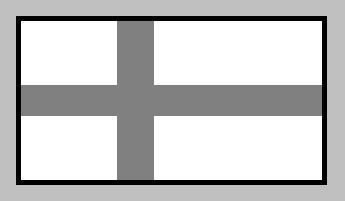 | ||
The term Nordic Cross flag describes certain flags bearing the design of the Nordic or Scandinavian cross, a cross symbol in a rectangular field, with the center of the cross shifted towards the hoist.
Contents
All of the Nordic countries except Greenland have adopted such flags in the modern period, and while the Scandinavian cross is named for its use in the national flags of the Scandinavian nations, the term is used universally by vexillologists, in reference not only to the flags of the Nordic countries.
The cross design represents Christianity, and the characteristic shift of the center to the hoist side is early modern, first described the Danish civil ensign (Koffardiflaget) for merchant ships in a regulation of 11 June 1748, which specified the shift of the cross center towards the hoist as "the two first fields must be square in form and the two outer fields must be 6/4 lengths of those". The Danish design was adopted for the flags of Norway (civil ensign 1821) and Sweden (1906), both derived from a common ensign used during the Union between Sweden and Norway 1818–1844, Iceland (1915) and Finland (1917); some of the subdivisions of these countries used this as inspiration for their own flags. The Norwegian flag was the first Nordic cross flag with three colours. All Nordic flags may be flown as gonfalons as well.
Flags of the Nordic countries
Note that some of these flags are historical. Also, note that flag proportions may vary between the different flags and sometimes even between different versions of the same flag.
Unofficial Nordic flags
These flags either do not have official status or represent various private entities. They have not been officially adopted and their use remains limited.
Germany
Nordic flags in Germany were historically used to allude to the nation's Germanic heritage and "Nordic" origins. Nordic flag designs very similar to Denmark's, Sweden's, and Norway's national flags were proposed as Germany's national flags in both 1919 and 1948, after World War I and World War II, respectively. Today, the Nordic cross is a feature in some city and district flags or coats of arms.
United Kingdom
A number of flags for localities in the United Kingdom (primarily Scotland) are based on Nordic cross designs, intended to reflect the Scandinavian heritage introduced to the British Isles during the Viking Age.
The flag of the city of Wilmington, Delaware is also a Nordic Cross flag. (Delaware was part of the colony of New Sweden.)
